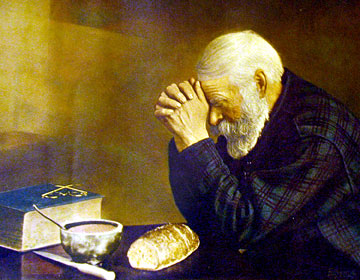Attitude of gratitude interpreted in famous photograph
COFFEE WITH WARREN, with Warren Harbeck
Cochrane Eagle, December 2, 2009

A reprint of Enstrom’s photograph, “Grace,” was given to Warren Harbeck in appreciation for his recent column on bread and prayer. Public domain photo by Eric Enstrom
My wife and I were just about to leave the house for an appointment when the doorbell rang. There, smiling in their typically gracious way, stood Cochrane coffee companions Pat and Maureen Long.
“We were wondering whether you would accept this photograph as a gift from us,” Pat said as he handed me a 10 × 14 inch mounted print.
But more about the gift in a moment.
I’ve written about Pat and Maureen before (Dec. 29, 2004). I shared how these two then-newcomers had just moved here from their home near Glastonbury, England, the area renowned for Avalon, King Arthur and the Holy Grail. They had even brought with them water from Glastonbury’s fabled Chalice Spring to bless our own Bow River as a prayerful expression of their desire for wholeness and unity in life.
Now this beautiful retired couple were extending another blessing, this time to me personally out of gratitude for my Nov. 18 column on bread, prayer and the kingdom of God.
“Yes,” Maureen said as I accepted their gift; “the Jewish prayer, in particular, really touched us.”
She was referring to the words said at the breaking of bread: “Blessed are you, Hashem (Lord) our God, King of the Universe, who brings forth bread from the earth.”
I recognized the photograph immediately. It was a reprint of photographer Eric Enstrom’s famous image, “Grace,” depicting an elderly man with his head bowed, grateful for the simple meal on the table before him. It resonated perfectly with the spirit of my column on prayer.
Their thoughtful gift moved me deeply, and over the next days I attempted to learn as much as I could about it.
Enstrom was a Minnesota photographer at the beginning of the 20th century. One day in 1918, a bearded peddler arrived at his studio in the mining town of Bovey, Minn.
"There was something about the old gentleman's face that immediately impressed me. I saw that he had a kind face . . . there weren't any harsh lines in it," Enstrom said, according to one especially helpful website (www.gracebyenstrom.com).
Enstrom seized the moment and posed the man at a table set with bread, bowl, knife, spoon, book and eyeglasses. “I wanted to take a picture that would show people that even though they had to do without many things because of the war they still had much to be thankful for,” he said.
The original image was black-and-white but was later enhanced with oils to yield the popular coloured version familiar to most of us today. In 2002 Minnesota declared “Grace” the state photograph.
When I next chatted with Pat and Maureen, they told me more about why the prayer and photograph of thanksgiving meant so much to them.
“Like so many people, I grew up with the table grace that you probably know, too,” Pat said: “Bless, O Lord, these Thy gifts, which we are about to receive from Thy bounty, through Christ, our Lord. Amen.”
He spoke of the happiness that comes from embracing this attitude of gratitude.
Then he shared a story of how that attitude expressed itself in day-to-day living among his neighbours back in England.
Grateful folks would prepare an extra plateful of food at mealtimes, he said. Then they would take the plate of food to the backyard fence and offer it to a person less fortunate who might come along.
This was the completion of the table grace, he said, for it was gratitude in action.
Well, Pat and Maureen’s gift to me was gratitude in action, too. It will hang on my office wall as a constant reminder to be thankful for my daily bread.
It will also remind me to be thankful for my daily friends.
© 2009 Warren Harbeck
JoinMe@coffeewithwarren.com